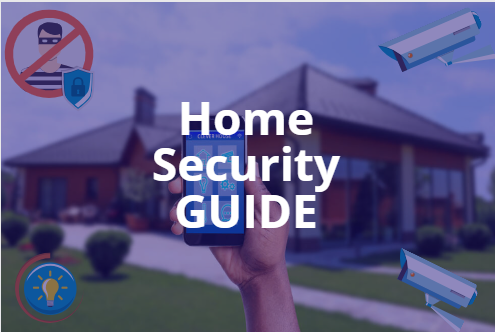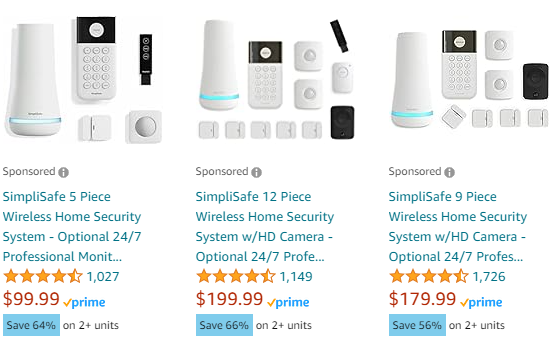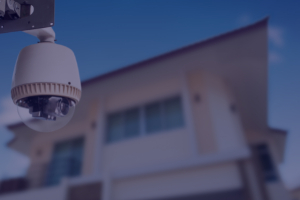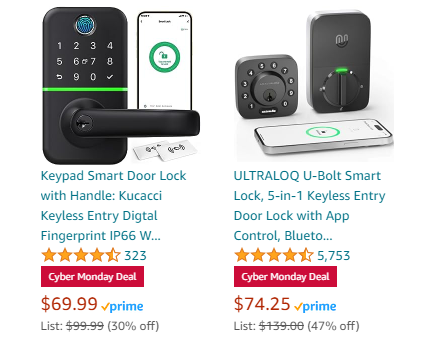Home Security: A Comprehensive Guide

Home Security, in today’s fast-paced and technologically advanced era, is not just a feature but a necessity for ensuring the safety and tranquility of our living spaces. With rising urbanization and evolving threats, a robust alarm system becomes crucial in protecting our families and possessions.
It offers more than just protection against intrusion; it brings peace of mind, a sense of control, and a safeguard for our most precious assets. Embracing advanced security solutions is key to creating a safe haven in our homes amidst the complexities of the modern world. How long does a fully charged portable charger last?
Table of Contents

The Evolution of Home Security
Home security has evolved significantly over the years. From simple locks and keys to sophisticated alarm systems, the journey reflects our growing need for safety and advancements in technology.
Historical Overview
The evolution of home security is a fascinating journey through history, reflecting humanity’s enduring quest for safety and protection. In ancient times, burglar alarm was rudimentary, often involving basic measures such as animal guards, wooden barricades, and simple locks made from wood or metal. As civilizations advanced, so did their methods of securing homes. The Middle Ages saw the introduction of moats, drawbridges, and fortified walls in castles, symbolizing the era’s emphasis on defense.
With the advent of the Industrial Revolution, technological advancements brought about significant changes in alarm system. The production of stronger, more durable metals led to the development of more sophisticated lock and key systems. The 19th century marked a significant shift with the introduction of the first mechanical burglar alarm, invented by Edwin Holmes in the 1850s, which used a simple electrical circuit and was a precursor to the modern alarm systems we see today.
The 20th century witnessed a rapid technological evolution in alarm system. The proliferation of telephone lines enabled the development of monitored alarm systems, allowing homeowners to connect their home security systems to a central monitoring station. This period also saw the advent of motion detectors, CCTV cameras, and electronic access control systems, offering more comprehensive and integrated security solutions.
Today, in the 21st century, home security is characterized by digital innovation and smart technology. Internet-connected devices and systems, from smart locks to AI-powered surveillance cameras, have revolutionized burglar alarm, making it more accessible, efficient, and user-friendly. The integration of home automation systems with security features has enabled real-time monitoring, remote control, and personalized security setups, reflecting the dynamic and evolving nature of home security in our modern world. Video Doorbell Camera: 5 Powerful Reasons to Invest Now

Technological Advances
Recent years have seen a surge in the use of technology in home security. Internet-connected devices, AI, and machine learning have transformed traditional security measures into smart, proactive systems.
The technological advances in alarm system have been transformative, marking a shift from traditional, reactive measures to proactive, smart solutions. In recent decades, the integration of digital technology and the Internet of Things (IoT) has revolutionized this domain. Early advancements included the development of electronic alarm systems and CCTV cameras, which allowed for better monitoring and recording capabilities. The advent of motion sensors further enhanced these systems, enabling the detection of unauthorized movement within protected areas. Upgrade Your Security with the Level Lock Connect WiFi Smart Lock & Keypad
With the onset of the 21st century, smart home technology took center stage. Home security systems began to incorporate internet connectivity, allowing for remote monitoring and control through smartphones and computers. This era saw the emergence of smart locks, doorbell cameras, and connected surveillance systems, which not only improved security but also added convenience for homeowners. Top 7 Must-Have Video Doorbells to Elevate Your Home Security Game!
Artificial intelligence (AI) and machine learning have further pushed the boundaries of burglar alarm. Modern systems can now distinguish between routine activities and potential threats, reducing false alarms and increasing efficiency. Facial recognition technology in surveillance cameras and advanced analytics for unusual activity detection are current frontiers in home security tech. How to make a homemade door security bar?
Moreover, the integration of alarm system with overall home automation systems has created a more holistic approach to security. Systems can now interact with lighting, heating, and other home systems, creating scenarios where, for instance, lights automatically turn on when motion is detected, further deterring potential intruders.
These technological advances have not only made home security systems more effective but also more accessible and user-friendly, offering peace of mind in an increasingly complex and connected world.
Types of Home Security Systems
Traditional Alarm Systems
These systems, though basic, are effective in deterring intruders. They typically include door and window sensors, alarms, and sometimes, monitoring services.

Traditional alarm systems, a cornerstone of alarm system for decades, serve as a fundamental layer of protection against intrusions. These systems primarily function through a network of sensors placed at strategic points, such as doors and windows, designed to detect unauthorized entry. When triggered, these sensors activate a loud alarm, serving both to alert the occupants of the home and to deter the intruder with its piercing sound. In addition to these basic features, many traditional alarm systems are also equipped with panic buttons and, in some cases, can be connected to a central monitoring service that notifies local law enforcement in the event of a breach.
What sets traditional alarm systems apart is their simplicity and reliability. They do not rely heavily on digital technology, making them less susceptible to cyber threats and more accessible to those who prefer straightforward security solutions. Moreover, these systems are often less expensive than their modern, smart counterparts, offering an effective security option for budget-conscious homeowners.
Despite their simplicity, traditional alarm systems have evolved over the years. Many now include the option to integrate with wireless technology, offering more flexibility in terms of installation and expansion. While they may not offer the advanced features of smart burglar alarm systems, such as remote control or integration with other smart home devices, traditional alarm systems continue to be a popular and trusted choice for homeowners seeking a robust and uncomplicated approach to securing their homes. Top 7 Must-Have Portable Chargers for On-the-Go Power!
Smart Home Security Systems
These are the next-gen systems that integrate seamlessly with other smart home devices, offering remote control and monitoring.
Smart Home Security Systems represent a quantum leap in the realm of home protection, merging cutting-edge technology with the traditional concept of security. These systems harness the power of the Internet of Things (IoT) to provide a level of interconnectivity and intelligence previously unimaginable. At the heart of these systems are centralized control hubs that communicate with various sensors and cameras placed around the property, all accessible via smartphone apps. This connectivity allows homeowners to monitor their homes remotely, receiving real-time alerts and video feeds whenever a sensor is triggered.
One of the standout features of smart alarm system systems is their adaptability. They can be customized extensively to fit individual needs, from setting up motion detectors in specific zones to programming smart locks to allow access during designated times. Additionally, these systems often integrate seamlessly with other smart home devices, like lighting and climate control, enhancing overall home automation.
Advancements in artificial intelligence (AI) and machine learning have further elevated the capabilities of smart burglar alarm systems. They can now learn from and adapt to homeowners’ habits, providing more accurate alerts and reducing the likelihood of false alarms. Facial recognition technology in some advanced systems adds an additional layer of security, distinguishing between known occupants and strangers.
Another significant advantage of smart home security systems is their scalability. As technology evolves or homeowners’ needs change, these systems can be easily upgraded or expanded with additional sensors and devices without the need for extensive rewiring or complex installation processes.
In summary, smart home security systems offer a dynamic, highly customizable, and user-friendly approach to burglar alarm, aligning with the contemporary lifestyle that values convenience, efficiency, and technological integration.
Surveillance Cameras
Cameras play a pivotal role in modern security systems. From simple webcams to advanced systems with night vision and motion detection, they are a key component in home surveillance.
Surveillance cameras have become a pivotal component of modern alarm system, offering a significant deterrent to potential intruders while providing homeowners with a means to monitor their property in real-time. These cameras come in various forms, from fixed-position models to those with pan-tilt-zoom capabilities, and are often equipped with features such as night vision, motion detection, and high-definition video quality. The advancement of technology has also introduced wireless cameras, which offer greater flexibility in placement and are easier to install without the need for extensive wiring.
The real power of surveillance cameras lies in their connectivity and integration with other smart home devices. Many modern cameras can be accessed remotely via smartphones or computers, allowing homeowners to view live feeds from anywhere in the world. This feature is particularly valuable for checking in on the home while away, be it for work or vacation. Some cameras also incorporate advanced features like facial recognition, which helps in identifying known individuals versus potential intruders, and two-way audio, enabling homeowners to communicate with visitors or deter unwanted guests.
Additionally, the presence of surveillance cameras serves as a psychological deterrent to burglars, who are more likely to avoid homes with visible security measures. Recorded footage from these cameras can also be crucial in the event of a crime, providing valuable evidence for law enforcement.
In essence, surveillance cameras have transformed burglar alarm, offering both a practical tool for monitoring and a robust deterrent against potential threats, thereby enhancing the overall safety and security of residential properties.
Motion Sensors
Motion sensors add an extra layer of security by detecting any unusual movement in and around your home.
Motion sensors are a vital and dynamic component of contemporary home security systems, offering an enhanced layer of protection by detecting any unusual activity within their range. These sensors work by identifying changes in the environment, such as movement or heat signatures, typically using infrared technology. Upon detecting motion, they trigger an alert, which can be configured to sound an alarm, send notifications to the homeowner’s smartphone, or activate connected devices like lights or cameras.
The versatility of motion sensors is one of their key strengths. They can be strategically placed in various locations around a home, such as near entry points, in hallways, or in outdoor areas that are vulnerable to intrusion. This placement ensures comprehensive coverage and acts as a strong deterrent to potential intruders, who are likely to be caught off-guard by the automatic response triggered by their movement.
Modern motion sensors are designed to be highly sensitive yet discerning, minimizing the likelihood of false alarms caused by small pets or routine movements within the home. Many are also capable of distinguishing between different types of movement, adding an extra layer of sophistication to the security system.
In smart alarm system setups, motion sensors play an integral role. They can be linked to other smart devices, creating an interconnected security network. For example, a sensor can trigger a camera to start recording as soon as movement is detected, providing real-time surveillance footage. Alternatively, lights can be programmed to turn on automatically, enhancing visibility and potentially startling an intruder.
Overall, motion sensors are a simple yet powerful tool in the arsenal of home security, offering an effective way to monitor and respond to potential threats, thereby contributing significantly to the safety and peace of mind of homeowners.
The Role of Technology in Home Security
Internet of Things (IoT) Integration
The integration of IoT has revolutionized burglar alarm, allowing for real-time alerts and remote control of security devices.
The integration of the Internet of Things (IoT) in alarm system has revolutionized the way we protect our homes, bringing a new level of sophistication and interactivity to security systems. IoT refers to the network of physical devices, from security cameras to door locks, which are connected to the internet and can communicate with each other. This connectivity enables a more cohesive and intelligent home security ecosystem.
With IoT integration, various components of a alarm system can work in tandem, offering seamless operation. For instance, a motion sensor can trigger a camera to start recording, while simultaneously sending an alert to the homeowner’s smartphone. This level of integration provides a more comprehensive approach to security, as actions are coordinated and automated based on real-time data.
Furthermore, IoT-enabled devices can be remotely controlled and monitored through mobile applications, providing homeowners with the ability to manage their security systems from anywhere in the world. This remote access is not only convenient but also offers a significant advantage in terms of response time to potential security breaches.
The use of IoT in burglar alarm also opens the door to advanced features like predictive analytics, where data collected from various sensors can be analyzed to anticipate and prevent security incidents before they occur. For example, unusual patterns of activity could be identified as potential security threats, allowing preemptive measures to be taken.
Overall, the integration of IoT in home security represents a paradigm shift towards more integrated, intelligent, and proactive security solutions, offering enhanced protection and peace of mind for homeowners.
Remote Monitoring and Control
This feature has become a game-changer, enabling homeowners to monitor their homes from anywhere in the world.
The advent of remote monitoring and control has been a game-changer in the field of alarm system, thanks to technological advancements. This feature allows homeowners to oversee and manage their security systems from any location, provided they have an internet connection. By using smartphones, tablets, or computers, individuals can now view live feeds from their surveillance cameras, receive instant alerts of any suspicious activities, and even interact with visitors through two-way communication systems, all in real-time.
This capability not only enhances the convenience of managing burglar alarm but also significantly increases its effectiveness. Homeowners can react swiftly to potential threats by remotely activating alarms, locking doors, or even contacting authorities directly from their devices. Remote monitoring also facilitates the checking-in on one’s home while away, be it for a short period or during extended travel, adding a layer of reassurance and control.
Moreover, the ability to control various aspects of home security remotely means that homeowners can adapt their security measures in response to changing situations. For instance, they can remotely adjust settings of their security cameras or motion sensors, ensuring optimal coverage and functionality. This adaptability is particularly useful in dynamic home environments or in situations where immediate action is required.
In essence, remote monitoring and control have empowered homeowners, giving them an unprecedented level of oversight and command over their alarm systems. This technological innovation not only provides peace of mind but also signifies a significant step forward in making home security systems more accessible, responsive, and user-friendly.
Choosing the Right Security System for Your Home
Assessing Your Security Needs
Before choosing a system, it's crucial to assess your specific security needs. Consider factors like the size of your home, neighborhood, and lifestyle.
Assessing your security needs is a critical first step in choosing the right alarm system. This process involves a careful evaluation of various factors unique to your home and lifestyle. Start by considering the layout of your home, noting potential vulnerabilities like ground-floor windows, less visible entry points, or areas that are poorly lit at night. The neighborhood’s safety profile and local crime rates also play a crucial role in determining the level of security required. Additionally, your lifestyle and routine should be taken into account. For example, if you travel frequently or are often away from home, a system with remote monitoring capabilities might be essential.
It’s also important to think about what you’re trying to protect. Beyond the physical structure of your home, consider the safety of family members, pets, and valuable possessions. Evaluate whether you need simple intrusion detection or more comprehensive solutions like fire and carbon monoxide monitoring.
Another aspect to consider is future scalability. Your security needs may evolve over time, so opting for a system that can be easily upgraded or expanded is wise. This foresight ensures that your security system can adapt to changing circumstances, such as a growing family or new technological advancements.
Finally, don’t overlook the ease of use and maintenance of the system. A complex system might offer more features but could be challenging to operate daily. A balance between sophistication and user-friendliness is key to ensuring that your security system is not just installed but actively and effectively used.
In summary, assessing your security needs requires a holistic view of your personal circumstances, potential risks, and lifestyle preferences. This thoughtful approach ensures that the chosen system not only provides adequate protection but also aligns seamlessly with your daily life.
Comparing Different Systems
It's important to compare features, costs, and reviews of different systems to find the one that best suits your needs.
When choosing the right security system for your home, comparing different systems is a crucial step. This comparison should go beyond just the initial cost and delve into various aspects such as features, ease of use, installation requirements, and the level of ongoing support offered. Begin by researching the most popular systems available, focusing on their core functionalities — such as intrusion detection, environmental monitoring, and home automation capabilities. It’s important to evaluate how well these systems integrate with your existing smart home devices if any, and how flexible they are in terms of scalability and customization.
Another key factor to consider is the type of monitoring each system offers. Decide whether you prefer professional monitoring services, which involve a dedicated team overseeing your system 24/7, or self-monitoring options, where you are in charge of keeping an eye on your home through mobile apps. Each option has its advantages and costs, and your choice will largely depend on your personal preferences and lifestyle.
Additionally, look into the reputation and customer service record of the companies behind these systems. Customer reviews, testimonials, and ratings can provide valuable insights into the reliability and user experience of different security systems. Pay attention to feedback regarding the responsiveness of customer support, especially in emergency situations, as this is a critical component of alarm system.
Lastly, consider the long-term costs associated with each system. This includes installation fees, monthly or annual subscription costs for monitoring services, and any additional expenses for maintenance or upgrades. A system that seems affordable initially may have higher ongoing costs, so it’s important to factor these into your decision-making process.
By thoroughly comparing different burglar alarm systems, you can make an informed decision that balances your security needs, budget, and lifestyle, ensuring optimal protection for your home and peace of mind for yourself and your family.
Budget Considerations
Home security systems come in a range of prices. It's important to find a balance between cost and the level of security provided.
Budget considerations play a pivotal role in selecting the appropriate home security system. It’s essential to establish a clear budget that accommodates not only the initial purchase and installation costs but also the long-term expenses associated with the system. The price range for alarm systems can vary widely, from basic, cost-effective solutions to high-end systems with advanced features and professional monitoring services. It’s important to strike a balance between affordability and the level of security you require.
When setting your budget, factor in potential installation fees, especially if you opt for a professionally installed system. Additionally, many advanced systems require a monthly or annual subscription for monitoring services, which can add up over time. It’s also wise to consider the costs of maintenance and potential upgrades. Some systems may offer low upfront costs but could become more expensive in the long run due to these additional expenses.
On the other hand, investing in a more expensive system with comprehensive features might offer greater value and peace of mind, particularly for those living in areas with higher security risks or for homeowners who have valuable assets to protect. In some cases, the cost of a security system may be offset by reductions in home insurance premiums, so it’s worthwhile to check with your insurance provider.
Ultimately, the key is to find a system that offers the best combination of features and reliability within your budget. It’s better to invest in a quality system that meets your core security needs rather than opting for a cheaper option that falls short in crucial areas. Careful budget planning and a thorough evaluation of ongoing costs will ensure that you choose a home security system that provides effective protection without straining your finances.
Installation and Maintenance
DIY vs Professional Installation
Some prefer the DIY route for installation, while others opt for professional services. Each has its pros and cons.
When it comes to installing a burglar alarm system, homeowners typically face the choice between DIY (Do-It-Yourself) and professional installation, each with its own set of advantages and considerations. DIY installation offers a more hands-on approach, often preferred by those who are comfortable with basic home improvement tasks. It provides flexibility in terms of scheduling and placement of devices, and can be more cost-effective, as it eliminates the need for professional service fees. Many modern home security systems are designed with the DIY user in mind, featuring straightforward setup processes and user-friendly interfaces.
On the other hand, professional installation ensures that your system is set up correctly and efficiently by experts who understand the intricacies of the system and can optimize sensor placements for maximum coverage and effectiveness. This option is particularly beneficial for more complex systems that involve intricate wiring or integration with existing home infrastructure. Professional installers can also provide valuable advice on how to use and maintain the system effectively.
Another factor to consider is time. A DIY installation may require a significant time investment, especially for those who are new to such tasks. Professional installation, while typically quicker, may require scheduling an appointment and possibly taking time off work.
In terms of reliability, professionally installed systems often come with service guarantees or ongoing support, which can be reassuring for homeowners who want the peace of mind that comes with knowing help is available if any issues arise.
Ultimately, the choice between DIY and professional installation depends on personal skills, the complexity of the system, time availability, and budget. Some homeowners may opt for a hybrid approach, installing basic components themselves and seeking professional help for more complex parts of the system.
Routine Maintenance Tips
Regular maintenance is key to ensuring your security system functions optimally. This includes checking batteries, updating software, and testing the system regularly.
Routine maintenance is crucial for ensuring your alarm system operates effectively and reliably over time. Firstly, it’s important to regularly check and replace batteries in wireless components such as sensors and cameras. Low battery levels can lead to system failures, so staying ahead of this can prevent unexpected gaps in your security coverage. Secondly, periodically test your system’s components to ensure they are functioning correctly. This includes testing alarms, motion detectors, and any other sensors to confirm they respond appropriately to potential security breaches.
Another key aspect of maintenance is keeping your security devices clean and free from obstructions. For example, cameras should be cleaned to ensure clear visibility, and sensors should be kept free of dust and debris that could hinder their sensitivity. Additionally, if your system is connected to the internet, ensure that its software is regularly updated. Software updates often include important security patches and performance improvements that can enhance the overall functionality and security of your system.
If you are subscribed to a monitored security service, it’s wise to review and update your contact information and emergency response plans periodically. This ensures that in the event of an alarm, the monitoring center can reach you promptly and take appropriate action.
For systems that include more complex components or integrated smart home features, consider scheduling annual or bi-annual check-ups with a professional. They can conduct thorough inspections and address any issues that might not be evident to the untrained eye.
Overall, routine maintenance of your home security system is a small investment of time and effort that can pay significant dividends in maintaining the safety and security of your home.
Enhancing Security with Smart Home Devices
Smart Locks and Doorbells
Smart locks and doorbells enhance security by allowing remote access control and providing visual and audio surveillance at entry points.

Smart locks and doorbells represent a significant advancement in alarm system, offering enhanced control and convenience for homeowners. Smart locks allow for keyless entry, enabling you to unlock your door with a smartphone app, a code, a fob, or even biometric recognition like fingerprints. This technology not only eliminates the risk of lost keys but also allows for remote management of access to your home. You can grant temporary access to guests or service personnel without physically being there, and you can easily change or revoke access permissions as needed.
Smart doorbells complement smart locks effectively. Equipped with cameras, these doorbells allow homeowners to see and communicate with visitors at their door, regardless of whether they’re at home or away. This feature is particularly useful for monitoring deliveries or deterring potential intruders who might ring the doorbell to check if anyone’s home. Many smart doorbells also include motion sensors, sending alerts to your phone when someone approaches your door, even if they don’t ring the bell.
Together, smart locks and doorbells enhance the security of your home by giving you more control over who enters and allowing you to monitor your home’s entrance remotely. They also integrate seamlessly with other smart home devices, such as security systems and smart lighting, to create a comprehensive, interconnected security network. This integration can provide scenarios like lights automatically turning on when someone approaches the door, further enhancing security and deterring potential intruders.
In summary, smart locks and doorbells are not just about convenience; they are a proactive approach to home security. They offer a modern solution for managing access to your home, ensuring you’re always in the loop about who is at your door, thereby increasing the safety and security of your living space.
Lighting and Motion Detectors
Intelligent lighting and motion detectors can deter burglars and enhance security, especially in vulnerable areas around your home.
Lighting and motion detectors are pivotal components in enhancing burglar alarm through smart home devices. Intelligent lighting systems can be programmed to turn on and off at specific times or in response to certain triggers, creating the appearance of someone being home even when the house is vacant. This can be an effective deterrent to potential burglars, as a well-lit home often signifies occupancy and vigilance. The integration of motion detectors elevates this security aspect further. These detectors can trigger lights to turn on automatically when movement is detected, startling intruders and drawing attention to their presence.
Modern motion detectors are highly sophisticated, with the ability to differentiate between routine movements, like pets in the yard, and unusual activity. They can be strategically placed around the property, especially in areas that are more susceptible to unauthorized entry, such as backyards, side entrances, and near windows. When linked with a home’s lighting system, they provide a reactive security measure that can dissuade trespassers effectively.
Additionally, many smart lighting and motion detector systems can be controlled remotely via smartphones or integrated into a broader home automation system. This allows for real-time adjustments and monitoring, giving homeowners the flexibility to enhance their home’s security based on their immediate needs. For instance, if a homeowner receives an alert of motion detected by their system while away, they can instantly review surveillance feeds and adjust lighting as needed to secure the area.
Incorporating lighting and motion detectors into a home’s security setup not only provides a practical deterrent against potential intruders but also adds a layer of convenience and efficiency. These smart devices offer a proactive approach to security, illuminating and protecting homes in more intelligent and responsive ways.
Safety Tips Beyond Technology
Neighborhood Watch Programs
Participating in or starting a neighborhood watch program can significantly enhance the security of your area.
Neighborhood Watch Programs play a vital role in community safety, complementing technological security measures. These programs foster a sense of collective responsibility among residents, encouraging them to look out for one another and report suspicious activities to authorities. By establishing a Neighborhood Watch, communities can create a network of vigilant eyes and ears, significantly enhancing the area’s overall security. These programs often involve regular meetings where neighbors can share concerns, disseminate information about recent local crime trends, and coordinate efforts with local law enforcement.
The effectiveness of a Neighborhood Watch Program lies in its ability to mobilize community members towards a common goal of safety and security. Participants are usually trained to recognize and report suspicious activities, effectively acting as a deterrent to potential criminals who are less likely to target neighborhoods where active, organized surveillance is present. Additionally, these programs often lead to the development of more robust communication channels within the community, such as social media groups or messaging chains, which can be used for rapid information sharing in case of emergencies.
Besides enhancing security, Neighborhood Watch Programs also strengthen community bonds. They encourage interaction and cooperation among residents, fostering a sense of belonging and mutual care. This community spirit can be particularly beneficial in times of crisis, where collective efforts and support are crucial.
In summary, while technology plays a significant role in alarm system, the human element remains invaluable. Neighborhood Watch Programs exemplify how community involvement and vigilance can effectively complement technological security measures, creating safer and more cohesive neighborhoods.
Personal Safety Practices
Adopting personal safety practices like being aware of your surroundings, securing valuables, and having emergency plans can go a long way
Personal safety practices are essential components of overall burglar alarm, offering an additional layer of protection that extends beyond technological solutions. One fundamental practice is to always be aware of your surroundings, especially when entering or leaving your home. Ensuring that doors and windows are locked, both when you are at home and away, is a simple yet effective way to deter potential intruders. It’s also prudent to be cautious about sharing personal information, such as your home address or travel plans, on social media platforms, as this can inadvertently alert potential burglars to your absence.
Good lighting around the home, especially at entry points, can be a significant deterrent to criminals. It’s advisable to use timers or smart lighting systems to keep your home well-lit, even when you’re not around. Additionally, keeping valuables out of sight from windows can reduce the temptation for thieves. In case of an emergency, it’s important to have a plan in place. This includes knowing the quickest escape routes from your home and having a designated meeting point for family members.
Another key aspect of personal safety is being cautious with strangers who come to your door. Installing a peephole or a video doorbells allows you to see who is outside without opening the door. It’s also wise to verify the identity of any service or delivery people before granting them access to your home.
For those living alone or in more vulnerable situations, consider additional precautions like a personal safety alarm or a trusted neighbor who can check in regularly. Finally, staying informed about local crime trends and attending community safety meetings can provide valuable insights and tools for enhancing your personal alarm system.
In essence, personal safety practices are about being proactive, vigilant, and prepared. These habits, when combined with technological security measures, create a comprehensive approach to protecting yourself and your home.
Success Stories in Home Security
Success stories in home security often highlight the pivotal role that effective systems play in safeguarding homes and families.
One common narrative involves homeowners who, thanks to their surveillance systems, were able to promptly alert law enforcement to break-ins, leading to the quick apprehension of intruders. In many cases, these systems captured high-quality footage that was crucial in identifying the suspects. Another frequent success story revolves around the use of smart alarm systems, where homeowners were able to deter potential burglars by remotely controlling lights and other devices, creating the illusion of presence even when they were miles away.
There are also numerous accounts of environmental monitoring systems preventing disasters. For instance, smoke and carbon monoxide detectors connected to smart security systems have been instrumental in alerting families to fires or gas leaks, allowing them to evacuate in time and prevent tragic outcomes. In addition, smart locks and doorbell cameras have provided many with peace of mind by allowing them to monitor and control who enters their homes, especially useful for parents who want to keep track of their children’s comings and goings.
These success stories not only underscore the effectiveness of home security systems in preventing and responding to potential threats but also highlight their role in bringing peace of mind to homeowners. The sense of security and control that comes with knowing your home is well-protected is invaluable, and for many, this is the ultimate success story of burglar alarm.
Common Mistakes to Avoid in Home Security
When it comes to home security, certain common mistakes can significantly compromise the effectiveness of your system. A frequent error is neglecting to activate the security system consistently. Many homeowners invest in sophisticated systems but then fail to arm them, especially during short trips or even at night, leaving their homes vulnerable. Another oversight is poor placement of cameras and sensors, which can lead to blind spots. Ensuring that all entry points and critical areas are adequately covered is crucial for comprehensive surveillance.
Here’s a list of common mistakes to avoid in alarm system:
- Not Using the Security System: Failing to consistently arm your security system, especially during short trips or at night.
- Inadequate Coverage: Poor placement of cameras and sensors leading to blind spots in surveillance.
- Neglecting Maintenance: Not regularly checking and updating security equipment, including software for smart devices.
- Weak Passwords: Using simple, easily guessable passwords for smart security systems.
- Lack of Layered Security: Relying solely on one type of security measure, like just a door lock or an alarm, instead of a multi-layered approach.
- Ignoring Environmental Threats: Overlooking the inclusion of smoke detectors, carbon monoxide sensors, and flood detectors in the security setup.
- Visible Valuables: Keeping valuables in sight through windows, which can attract burglars.
- Unsecured Wi-Fi Networks: Using unsecured or poorly protected Wi-Fi networks, which can be exploited to access smart home devices.
- Overlooking Software Updates: Failing to install security patches and updates for smart security devices.
- Ignoring Door and Window Locks: Neglecting to lock doors and windows, even when the alarm system is armed.
- Disregarding Light Timers: Not using light timers or smart lighting to create the appearance of someone being home.
- Not Using Security Signage: Failing to display security system signage that can act as a deterrent to potential intruders.
- Forgetting to Change Locks: Not changing locks after moving into a new home or losing keys.
- Lack of Communication with Neighbors: Failing to communicate or cooperate with neighbors for community safety and alert systems.
- Oversharing on Social Media: Sharing information about being away from home on social media platforms.
Avoiding these mistakes can significantly enhance the safety and efficacy of your home security measures.
Many people also underestimate the importance of maintaining their security equipment. Regular checks and updates are necessary to keep the system functioning optimally. Outdated software in smart security devices can lead to vulnerabilities, making the system easier for tech-savvy burglars to bypass. Additionally, using simple, easily guessable passwords for smart security systems can pose a significant risk; strong, unique passwords are essential for maintaining security.
Ignoring the need for layered security is another common mistake. Relying solely on a single element, like just a door lock or an alarm, can be insufficient. A combination of measures – such as motion detectors, window sensors, and surveillance cameras – provides a more robust defense.
Lastly, some homeowners fail to consider environmental threats, focusing only on intrusions. Integrating smoke detectors, carbon monoxide sensors, and flood detectors into the burglar alarm system is also vital for comprehensive protection against a range of potential risks.
Being aware of and actively avoiding these common mistakes can significantly enhance the effectiveness and reliability of your alarm system. 11 Things to Do at Home Before Going on vacation
Expert Opinions and Advice
Expert opinions and advice in the field of home security often emphasize the importance of a holistic approach to protecting your home. Security professionals advocate for a combination of physical security measures, such as high-quality locks and sturdy doors, along with electronic systems like alarms and surveillance cameras. Experts also stress the significance of integrating smart technology, which offers remote monitoring and control, enhancing the overall security infrastructure. They advise homeowners to regularly review and update their security plans, taking into account the latest technological advancements and evolving personal needs.
Another key piece of advice from experts is the importance of awareness and education. They suggest staying informed about local crime trends and understanding the capabilities and limitations of your security system. Regular training on how to operate the system effectively and respond in an emergency situation is crucial.
In addition, experts often recommend professional installation and maintenance of security systems, especially for more complex setups, to ensure optimal functionality and reliability. They also highlight the value of community involvement, like participating in neighborhood watch programs, as an effective supplement to technological measures.
Lastly, experts caution against complacency. They remind homeowners that security is an ongoing concern and requires constant vigilance. Regular assessments and upgrades of security measures, along with adopting safe practices like not leaving spare keys outside and being cautious about sharing personal information, are essential steps in maintaining a secure home environment. Looking for a new job? Best 5 Tips to Land Your Dream
FAQ:
Question 1: What is the best home security system?
Answer 1: The “best” alarm system varies depending on individual needs, preferences, and budget. However, a top-rated system typically offers a combination of reliable intrusion detection, environmental monitoring (like smoke and carbon monoxide detection), and smart home integration.
1. Vivint: Best Overall.
2. SimpliSafe: Best DIY Installation.
3. ADT: Best Professional Monitoring Service.
4. Ring: Best Self-Monitored System.
5. Cove burglar alarm: Best Pro-Monitoring Pricing.
6. Abode: Best Home Automation Compatibility.
7. Frontpoint: Best Splurge.
8. Brinks: Best Installation Options.
Look for systems that provide real-time alerts, remote access via mobile apps, and customizable features. Systems with professional monitoring services are highly recommended for comprehensive security, though self-monitored systems can be effective for those comfortable with overseeing their own security. It’s also important to consider factors like ease of installation, customer service, and scalability to ensure the system can adapt to your evolving needs. Ultimately, the best system is one that fits seamlessly into your lifestyle and provides the level of security and peace of mind you’re seeking.
Question 2: What is the best free home security system?
Answer 2: The best free alarm system typically involves utilizing tools and strategies that don’t incur ongoing costs.
1. SimpliSafe – Best Equipment Value.
2. abode – Best for Smart Home Security.
3. Ring Alarm – Best System With Cameras and Doorbells.
4. Arlo – Best Security Camera System.
One effective approach is to leverage your smartphone and personal devices. Many apps can turn old smartphones or tablets into security cameras, providing basic surveillance without additional expense. Additionally, practicing robust personal safety habits, like ensuring doors and windows are securely locked, maintaining good outdoor lighting, and being vigilant about your surroundings, can significantly enhance burglar alarm.
For community-based solutions, participating in or starting a Neighborhood Watch program can be an effective and free way to boost security. This fosters a community spirit of looking out for one another and reporting any suspicious activities.
While these free options can provide a basic level of security, they may lack the comprehensive protection offered by paid systems, such as professional monitoring, advanced technology integration, and emergency response services. Therefore, while there are free methods to improve home security, they are often most effective when combined with other paid security measures for complete coverage.
Question 3: How much does a good home security system cost?
Answer 3: The cost of a good alarm system system can vary widely depending on several factors, such as the level of technology, the type of monitoring, and the scale of the system. Basic DIY systems can start from as low as $100 to $300, which typically includes a set of sensors and a central hub. More advanced systems, which offer features like smart home integration, high-quality cameras, and professional installation, can range between $300 and $1,000.
In addition to the initial setup cost, many systems also require a monthly or annual fee for professional monitoring services. These fees can range from around $15 to $50 per month, depending on the level of service and features included.
It’s important to note that while higher costs often correlate with more features and better quality, the most expensive option is not always the best for every situation. Balancing your specific security needs, budget, and the value of the features offered by the system is key to determining the best option for your home.
Question 3: How much does a good home security system cost?
Answer 3: When it comes to the best home security systems, Ring Alarm, Vivint, and ADT are often ranked as the top three companies. Each of these providers offers unique features and services catering to different needs. Ring Alarm is particularly notable, as it leads in several categories. It’s ranked first in our ratings for the Best Professionally Installed burglar alarm Systems, offering expert setup and maintenance for those who prefer a hands-off approach.
Additionally, Ring Alarm tops the list in the Best Self-Monitored Home Security Systems, appealing to users who want direct control over their security monitoring without a monthly fee. It’s also recognized for its excellence in the Best Wireless Home Security Systems category, providing flexibility and ease of installation with wireless components.
Vivint is renowned for its advanced smart home integration, offering a comprehensive system that combines burglar alarm with automation. Their systems are customizable and include a range of devices such as indoor and outdoor cameras, smart locks, and thermostats, all controllable via a single app.
ADT, one of the most established names in home security, is known for its reliable monitoring services and a broad range of security equipment. Their systems are ideal for those seeking traditional, professionally monitored burglar alarm solutions with the reassurance of a well-known brand.
Ultimately, the choice of the best alarm system system depends on individual requirements such as budget, the desired level of monitoring, home size, and the importance of smart home integration. It’s recommended to thoroughly research and compare these systems to determine which one aligns best with your specific home security needs.
- good home security systems
- vivint smart home security
- best home security cameras
- projectile gun bundle
- smart home security
- protect your held
- nonlethal selfdefense projectile
- security cameras vs surveillance
- pepper nonlethal selfdefense
- highly recommended products
- selfdefense projectile gun
- surveillance cameras pros
When choosing a home security system, people typically consider the following criteria:
Security Needs: Assessing the specific security requirements based on home size, neighborhood, and personal lifestyle. - 100%
Budget: Determining affordability, including initial setup costs, monthly monitoring fees, and long-term maintenance expenses. - 99%
System Features: Looking for essential features like intrusion detection, environmental monitoring, and smart home compatibility. - 97%
Ease of Use: Ensuring the system is user-friendly and easy to operate on a daily basis. - 98%
Installation: Deciding between DIY installation for simplicity and cost-effectiveness, or professional installation for expertise and efficiency. - 99%
Monitoring Options: Choosing between professional monitoring services for constant surveillance or self-monitoring for more hands-on control. - 89%
Integration with Smart Home Devices: Evaluating compatibility with existing smart home technology for a cohesive home automation experience. - 93%
Brand Reputation and Reviews: Researching the reputation of the brand, customer feedback, and expert reviews to gauge reliability and customer satisfaction. - 89%
Flexibility and Scalability: Considering whether the system can be expanded or upgraded easily in the future as needs change. - 87%
Customer Support and Warranty: Looking at the level of customer service provided and the warranty terms for the system and its components. - 86%
Mobile App and Remote Access: Ensuring the system offers remote control and monitoring through a smartphone app for convenience and real-time alerts. - 100%
Wireless vs. Wired Systems: Deciding between the reliability of wired systems and the flexibility of wireless setups. - 85%
Aesthetic Impact: Considering how the system's components will fit into the home's décor and whether they are obtrusive or discreet. - 82%
Data Security and Privacy: Ensuring the system provides robust data protection and respects user privacy, especially for systems connected to the internet. - 90%
92%
Score
Each of these criteria plays a role in helping individuals choose a home security system that aligns with their specific needs, preferences, and lifestyle.






